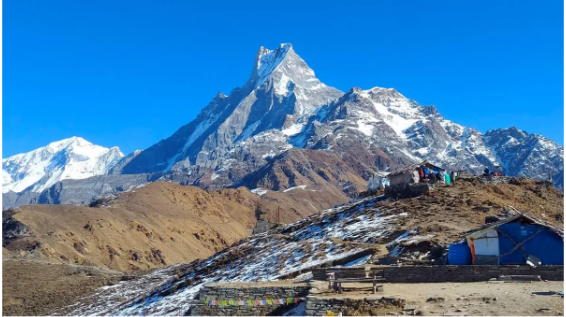The Annapurna Circuit Trek stands as one of the most iconic and rewarding treks in the world. Renowned for its dramatic scenery, cultural diversity, and varied landscapes, the circuit encircles the Annapurna Massif, taking trekkers through lush subtropical forests, alpine meadows, high mountain deserts, and over one of the highest trekking passes in the world — Thorong La (5,416 meters).
Unlike single-destination treks, the Annapurna Circuit Trek offers a diverse, immersive journey through both the natural and cultural heart of Nepal. From traditional Gurung and Thakali villages to sacred temples and Buddhist monasteries, this trek offers not just breathtaking views, but also deep cultural connection.
Why Choose the Annapurna Circuit Trek?
- Diverse landscapes ranging from rice paddies to snowfields
- Cultural immersion in remote Himalayan villages
- Panoramic views of Annapurna I, II, III, IV, Dhaulagiri, Manaslu, and Machapuchare
- High-altitude adventure with a challenging but rewarding pass at Thorong La
- Natural wonders like the Kali Gandaki Gorge (world’s deepest), Tilicho Lake, and hot springs in Tatopani
Trek Overview & Sample Itinerary
While the full Annapurna Circuit traditionally took 18–21 days, the construction of roads in parts of the region has shortened the trekking time. A typical trek now lasts 12–16 days, depending on the chosen entry and exit points.
Day 1: Drive from Kathmandu to Besisahar, then to Jagat (1,300m)
A long but scenic drive brings you to Jagat, the starting point for many modern circuit treks. The trail begins with a mix of forested paths and stone steps.
Day 2–3: Trek to Dharapani and then to Chame (2,670m)
The trail gradually ascends through subtropical forests and traditional villages. In Chame, the gateway to the upper Marsyangdi Valley, you’ll start seeing the dramatic peaks of Lamjung Himal and Annapurna II.
Day 4–5: Trek to Pisang and then to Manang (3,540m)
This section offers some of the best views of the trek. Between Lower Pisang and Manang, take the high route through Ghyaru and Ngawal for sweeping panoramas. Manang is a cultural hub, with monasteries and bakeries — and it’s the perfect spot for a rest and acclimatization day.
Day 6–7: Acclimatization in Manang, trek to Yak Kharka (4,050m)
Spend a day in Manang hiking to nearby viewpoints or the Gangapurna Lake. Then continue to Yak Kharka, a small settlement in the alpine zone.
Day 8: Trek to Thorong Phedi or High Camp (4,540m)
Climb gradually to the base of Thorong La Pass. Sleep early, as you’ll start the next day’s hike before sunrise.
Day 9: Cross Thorong La Pass (5,416m), descend to Muktinath (3,800m)
The most challenging yet rewarding day of the trek. After reaching the summit of Thorong La, enjoy magnificent views of the Dhaulagiri range before descending to Muktinath, a sacred site for both Hindus and Buddhists.
Day 10–11: Trek to Jomsom via Kagbeni or detour through Lupra
Visit Kagbeni, a medieval village with Tibetan influences, and trek to Jomsom, a windswept town in the Kali Gandaki Valley.
Day 12: Fly or drive back to Pokhara
From Jomsom, you can take a scenic flight back to Pokhara or trek further via Tatopani and Ghorepani Poon Hill if time allows.
Best Time to Trek
The Annapurna Circuit is best undertaken during:
- Spring (March to May): Clear skies, blooming rhododendrons, and pleasant temperatures.
- Autumn (September to November): Best weather conditions with crisp air and excellent mountain visibility.
- Winter (December to February): Fewer trekkers and snow-covered landscapes; pass may be closed due to heavy snow.
- Monsoon (June to August): Not ideal due to landslides and leeches, although the northern Mustang region lies in a rain shadow.
Permits and Logistics
To trek the Annapurna Circuit, you’ll need:
- ACAP (Annapurna Conservation Area Permit)
- TIMS (Trekkers’ Information Management System) Card
These are easily arranged in Kathmandu or Pokhara, or through a licensed trekking agency. Trekkers can go independently or with a guide/porter, though going with a local expert adds safety and cultural depth.
Difficulty and Preparation
The trek is considered moderate to strenuous due to the high altitude and long days of walking. However, with proper acclimatization, basic fitness training, and preparation, it is achievable for most healthy individuals.
Tips for preparation:
- Train with cardio and endurance workouts
- Invest in good hiking boots and gear
- Stay hydrated and ascend gradually
Cultural Highlights
The trek passes through a mosaic of ethnic villages — Gurung, Thakali, and Tibetan communities. Along the way, you’ll encounter Buddhist monasteries, prayer wheels, mani walls, and chortens, enriching your experience with spiritual and cultural depth.
Final Thoughts
The Annapurna Circuit Trek is not just a physical journey but a spiritual and cultural odyssey. It’s where Himalayan beauty meets local tradition, offering everything from adrenaline-filled high-altitude passes to peaceful nights in mountain lodges. Whether you’re drawn by the promise of panoramic peaks or the allure of remote village life, the Annapurna Circuit delivers a trekking experience that stays with you long after you’ve descended.

